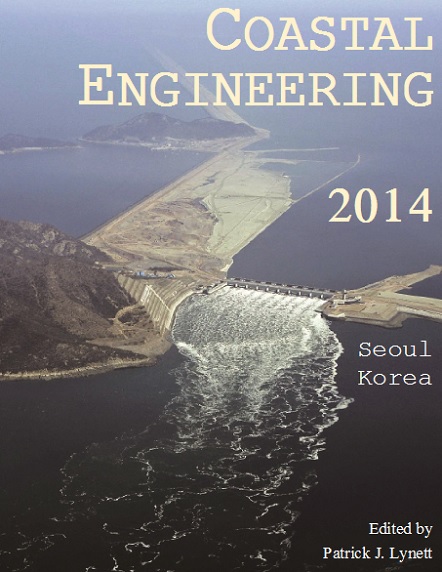Abstract
In this paper, interaction of a nonlinear solitary wave with a submerged breakwater as well as a breakwater with zero freeboard are modeled using Computational Fluid Dynamic (CFD). Simulation results of water particle velocities as well as water surface elevations at the vicinity of breakwater are validated by comparison to experimental data. In order to find out the best turbulence modeling appropriate for wave-breakwater interaction problem, simulations are conducted using standard K-Epsilon, SST-K Omega, and inviscid models available within the CFD software. In cases involving wave breaking, simulations are also repeated using second order SST-K-Omega model. The overall pattern of the wave interaction with breakwater is adequately reproduced by the CFD software. The processes of wave reflection, wave breaking, and vortical motion at the vicinity of breakwater are correctly captured. The good results achieved are promising regarding the use of CFD for design of breakwaters and other marine structures subject to waves.References
Mehrdad Bozorgnia and Jiin-Jen Lee. Computational fluid dynamic analysis of highway bridges exposed to hurricane waves. Coastal Engineering Proceedings, 1(33), 2012. URL http://journals.tdl.org/icce/index.php/icce/article/view/6723.
Mehrdad Bozorgnia and Jiin-Jen Lee. Wave structure interaction during hurricane ivan simulated by a two-phase flow model. Coastal Hazards, pages 33-44, 2013. doi: 10.1061/9780784412664.004.
Mehrdad Bozorgnia, Jiin-Jen Lee, and Frederic Raichlen. Wave structure interaction: Role of entrapped air on wave impact and uplift forces. Coastal Engineering Proceedings, 1(32), 2011. URL http://journals.tdl.org/icce/index.php/icce/article/view/1358.
CD-adapco. User guide for star-ccm+ version 5.06.010. 2010.
Ferziger, H. Joel, and Milovan Peric. Computational Methods for Fluid Dynamics. Springer-Verlag, Berlin, 2002.
C.W. Hirt and B.D. Nichols. Volume of fluid (vof) method for the dynamics of free boundaries. Comput. Phys., pages 201-225, 1981.
W.P Jones and B.E Launder. The prediction of laminarization with a two-equation model of turbulence. International Journal of Heat and Mass Transfer, 15(2):301-314, February 1972. ISSN 00179310. doi: 10.1016/0017-9310(72)90076-2. URL http://linkinghub.elsevier.com/retrieve/pii/0017931072900762.
B.E. Launder and B.I. Sharma. Application of the energy dissipation model of turbulence to the calculation of flow near a spinning disc. Letters in Heat and Mass Transfer, 1(2):131-137, November 1974. ISSN00944548. doi: 10.1016/0094 4548(74)90150-7. URL http://www.sciencedirect.com/science/ article/pii/0094454874901507.
Inigo J. Losada, Javier L. Lara, Raul Guanche, and Jose M. Gonzalez-Ondina. Numerical analysis of wave overtopping of rubble mound breakwaters. Coastal Engineering, 55(1):47-62, January 2008. ISSN 03783839. doi: 10.1016/j.coastaleng.2007.06.003. URL http://linkinghub.elsevier.com/retrieve/pii/S0378383907000713.
S. Mozaferija and M. Peric. Computation of free surface flows using interface-tracking and intefacecapturing methods. Computational Mechanics Publications, chap 2, 1998.
Fredric Raichlen, Jack C. Cox, and Jerald D. Ramsden. Inner Harbor Wave Conditions due to Breakwater Overtopping. In Coastal Engineering Practice (1992), pages 425-446. ASCE, 1992. URL http://cedb.asce.org/cgi/WWWdisplay.cgi?75180.
F Zhuang and JJ Lee. A viscous rotational model for wave overtopping over marine structure. Coastal Engineering Proceedings, pages 2178-2191, 1996. URL http://journals.tdl.org/icce/index.php/icce/article/viewArticle/5373.

